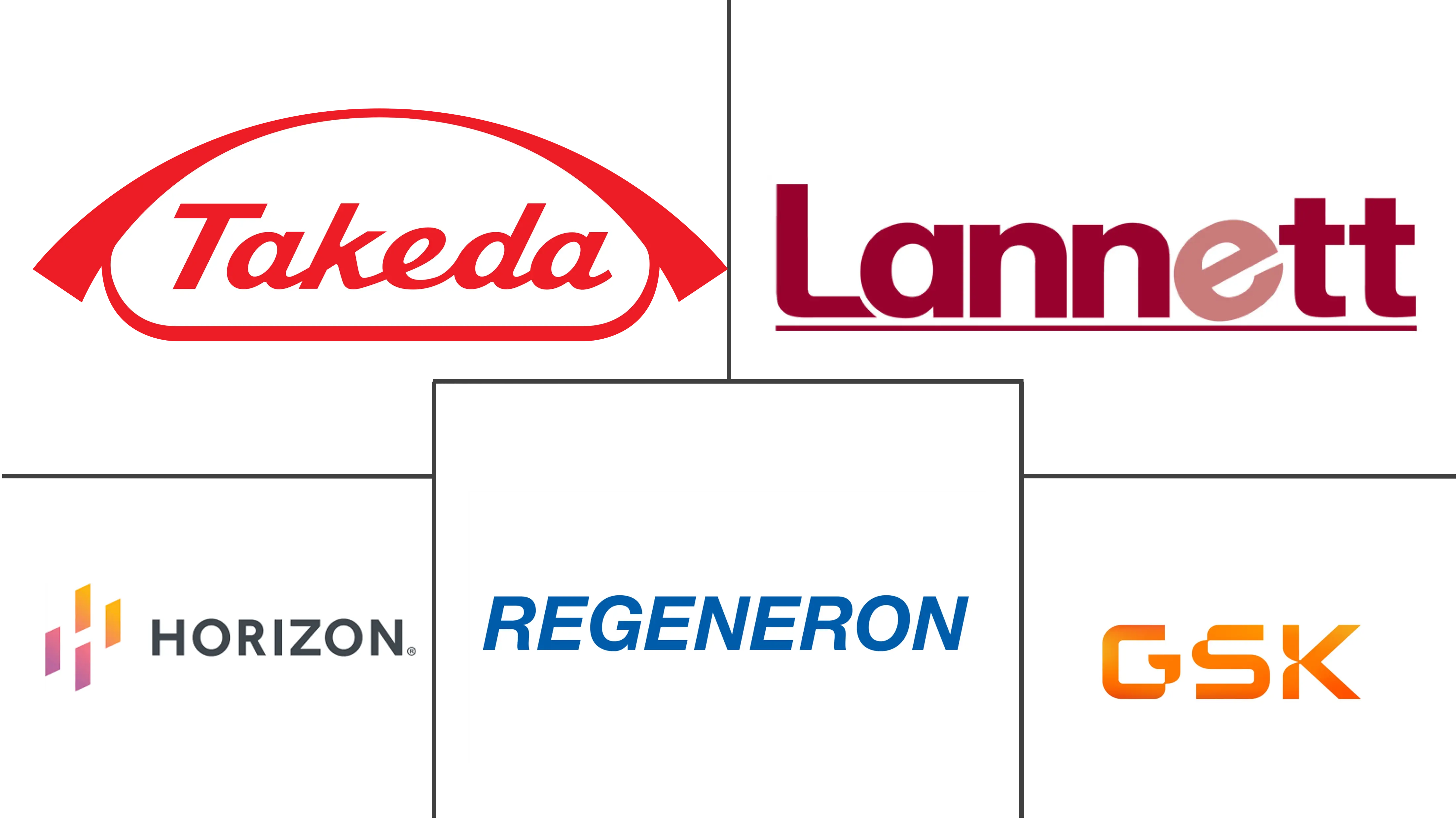Global Gout Therapeutics Market Size and Share
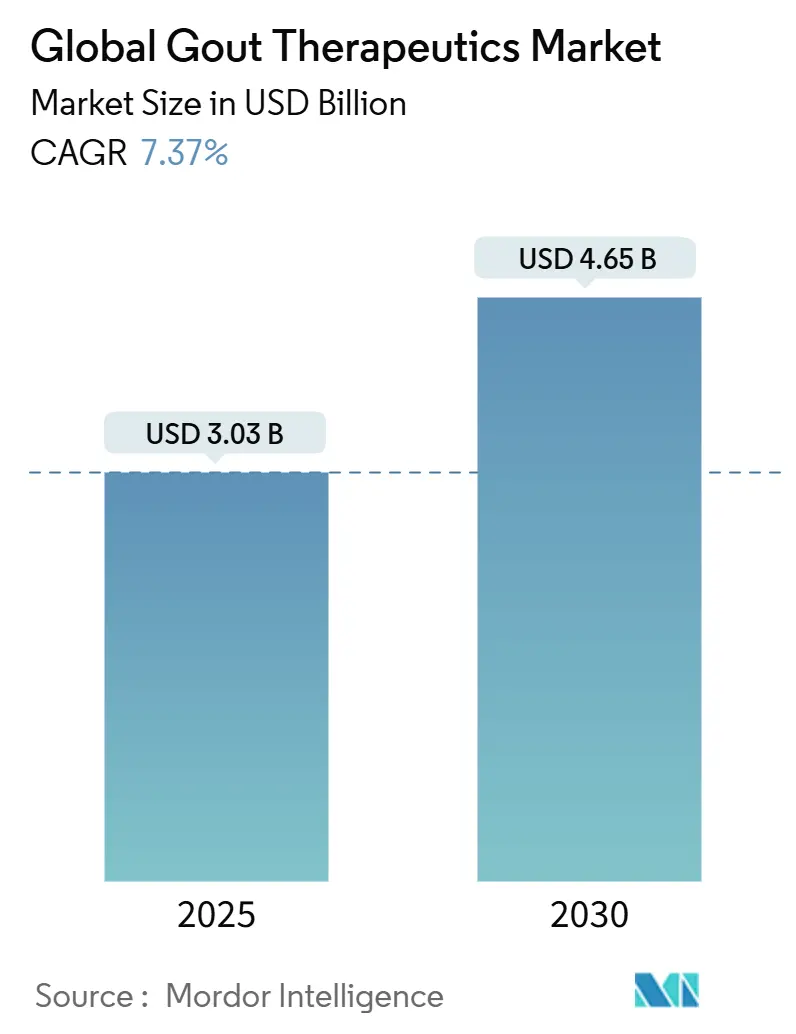
Global Gout Therapeutics Market Analysis by Mordor Intelligence
The gout therapeutics market generated USD 3.03 billion in 2024 and is forecast to reach USD 4.65 billion by 2030, advancing at a 7.37% CAGR during 2025-2030. Rising disease prevalence tied to aging populations, metabolic syndrome, and obesity continues to enlarge the treated patient pool, while precision approaches such as pharmacogenomic testing and real-time serum-urate wearables are lifting diagnosis and treatment rates. Regulatory catalysts—including multiple Fast Track designations and an accelerating approval cycle for biologics—shorten time-to-market for novel agents, and companies are using these pathways to expand indications or launch next-generation URAT1 inhibitors. Supply-chain disruptions around febuxostat and lingering NSAID safety concerns are reshaping prescriber preferences toward alternative mechanisms, especially in cardiovascular-risk cohorts. Against this backdrop, the gout therapeutics market is benefiting from growing payer recognition that aggressive serum-urate control averts costly complications, which is supporting coverage for combination therapy, biologics, and companion diagnostics.
Key Report Takeaways
- By drug class, xanthine oxidase inhibitors led with 46.34% of gout therapeutics market share in 2024, whereas URAT1 inhibitors post the fastest 8.12% CAGR through 2030.
- By route of administration, oral formulations held an 81.23% revenue share in 2024; injectable biologics are expected to grow at an 8.45% CAGR to 2030.
- By disease type, chronic refractory gout accounted for 52.40% of the gout therapeutics market size in 2024, while tophaceous gout is expanding at an 8.89% CAGR.
- By geography, North America captured 41.72% of 2024 revenue; Asia-Pacific registers the strongest 9.34% CAGR over the forecast horizon.
Global Gout Therapeutics Market Trends and Insights
Driver Impact Analysis
| Driver | (~) % Impact on CAGR Forecast | Geographic Relevance | Impact Timeline |
|---|---|---|---|
| Rising prevalence of gout driven by aging & obesity | +1.80% | Global, with highest impact in North America & APAC | Long term (≥ 4 years) |
| Treat-to-target adoption of urate-lowering guidelines | +1.20% | Global, led by North America & EU | Medium term (2-4 years) |
| Biologics & next-gen URAT1 approvals (e.g., AR882, SEL-212) | +2.10% | North America & EU, expanding to APAC | Medium term (2-4 years) |
| Fast-track FDA programs for refractory gout therapies | +0.90% | North America, with spillover to global markets | Short term (≤ 2 years) |
| Pharmacogenomics & wearable sUA monitoring enable personalization | +0.70% | North America & EU initially, APAC adoption following | Long term (≥ 4 years) |
| Tele-rheumatology & e-pharmacy expansion in emerging markets | +0.60% | APAC core, spill-over to MEA and Latin America | Medium term (2-4 years) |
| Source: Mordor Intelligence | |||
Rising prevalence of gout driven by aging & obesity
Global cases climbed to more than 53 million in 2024, a 22.4% jump in age-standardized rates since 1990, and the trend is most pronounced among men older than 55 where prevalence exceeds 2,500 per 100,000 individuals. Aging populations in high-income nations combine with escalating obesity in urbanizing Asia-Pacific economies, broadening the base eligible for long-term urate-lowering therapy. Pacific Island communities illustrate genetically driven hyperuricemia compounded by rapid dietary westernization, a pattern expected to replicate across emerging markets. Persistent demand growth underpins steady expansion of the gout therapeutics market in both established and nascent healthcare systems.
Treat-to-target adoption of urate-lowering guidelines
Guidance from European and US rheumatology societies recommending serum urate below 6 mg/dL has recast gout management from episodic flare control to proactive disease modification. Health insurers increasingly reimburse serial serum-urate testing, combination therapy, and specialist visits because evidence shows that achieving target levels mitigates cardiovascular events. Although only 28.9% of US gout patients receive urate-lowering therapy today, compliance is expected to rise as digital adherence tools and pharmacist-led programs scale. Wider guideline adherence boosts average treatment duration per patient, directly enlarging the gout therapeutics market.
Biologics & next-gen URAT1 approvals (e.g., AR882, SEL-212)
AR882 won FDA Fast Track in August 2024 after Phase 3 data showed 50% complete tophus resolution at 12 months, while SEL-212 entered a rolling BLA on superior efficacy to pegloticase. These agents directly address roughly 200,000 US patients with chronic refractory gout, shifting the competitive field toward precision urate transport inhibition. As renal-safe URAT1 inhibitors move through late-stage trials, payers view them as cost-offsetting alternatives for patients with CKD who cannot escalate xanthine oxidase inhibitors. Portfolio-diversified companies with biologics and small-molecule URAT1 assets stand to capture outsized share of incremental gout therapeutics market growth.
Fast-track FDA programs for refractory gout therapies
Two gout assets received Fast Track status in 2024, reflecting regulator acknowledgment of significant unmet need among the 3-5% of US patients unresponsive to existing drugs. Accelerated review trims development timelines by up to 18 months and incentivizes early investment in companion diagnostics. Developers leveraging expedited pathways can achieve first-mover advantage and command premium pricing, further contributing to revenue momentum in the gout therapeutics market.
Restraint Impact Analysis
| Restraint | % Impact on CAGR Forecast | Geographic Relevance | Impact Timeline |
|---|---|---|---|
| Boxed-warning safety issues for febuxostat & long-term NSAID use | -1.40% | Global, with highest impact in North America & EU | Short term (≤ 2 years) |
| Poor adherence owing to chronic dosing & flare paradox | -0.80% | Global, particularly in emerging markets with limited healthcare access | Long term (≥ 4 years) |
| Branded-drug withdrawals causing price erosion & lower R&D ROI | -0.60% | North America & EU primarily, with spillover to global generics markets | Medium term (2-4 years) |
| Regulatory scrutiny on purine-rich food advertising dampening demand | -0.20% | Global, with varying enforcement across regions | Long term (≥ 4 years) |
| Source: Mordor Intelligence | |||
Boxed-warning safety issues for febuxostat & long-term NSAID use
The February 2023 FDA boxed warning that links febuxostat to greater cardiovascular mortality restricted its use to allopurinol-intolerant patients, cutting addressable volume by 70-80% fda.gov. Takeda’s decision to withdraw branded Uloric in January 2025 underscores the commercial fallout. Similar cardiovascular and renal risk profiles limit extended NSAID courses, prompting prescribers to favor costlier but safer mechanisms such as URAT1 inhibition or biologics, which elevates therapy costs and complicates formulary access.
Poor adherence owing to chronic dosing & flare paradox
Adherence rates dip below 40% globally because initiating urate-lowering therapy often triggers flares that erode patient trust. The requirement for lifelong daily medication contrasts with patient expectations for episodic relief, and provider knowledge gaps around prophylactic anti-inflammatory cover exacerbate early discontinuation. Wearable uric-acid sensors and tele-rheumatology platforms are being deployed to flag non-adherence early, yet the behavior barrier continues to cap realized growth in the gout therapeutics market.
Segment Analysis
By Drug Class: URAT1 Innovation Challenges XOI Dominance
Xanthine oxidase inhibitors captured 46.34% of gout therapeutics market share in 2024 on the strength of inexpensive generic allopurinol and brand-loyal febuxostat users. The segment still expands, but its 4% CAGR lags behind URAT1 inhibitors, whose 8.12% rate is redefining the gout therapeutics market size for uricosurics. Clinical data show that URAT1 inhibition retains efficacy even when ABCG2 polymorphisms blunt allopurinol response in over 50% of patients. These genetic insights dovetail with payer interest in precision medicine, pushing formulary committees to re-evaluate step-therapy rules that historically favored xanthine oxidase inhibition.
Pipeline dynamism favors innovators. AR882 and dotinurad headline a cohort of small-molecule URAT1 agents designed for once-daily oral dosing without oxypurinol accumulation, offering renal-safe profiles and fewer drug-drug interactions. Recombinant uricase biologics hold their niche in chronic refractory gout where tophi burden is high; pegloticase revenues rose 33% year-on-year before Amgen’s acquisition of Horizon Therapeutics consolidated the category reuters.com. Meanwhile, IL-1 inhibitors such as canakinumab earned an adult-flare indication in December 2023[1]Source: Food and Drug Administration, “Ilaris (canakinumab) injection supplemental biologics license application approval letter,” fda.gov , signaling expansion of anti-inflammatory biologics that complement urate-lowering backbones. Collectively, these evolving classes continue to broaden the gout therapeutics market by offering differentiated options matched to genetic, renal, and cardiovascular profiles.
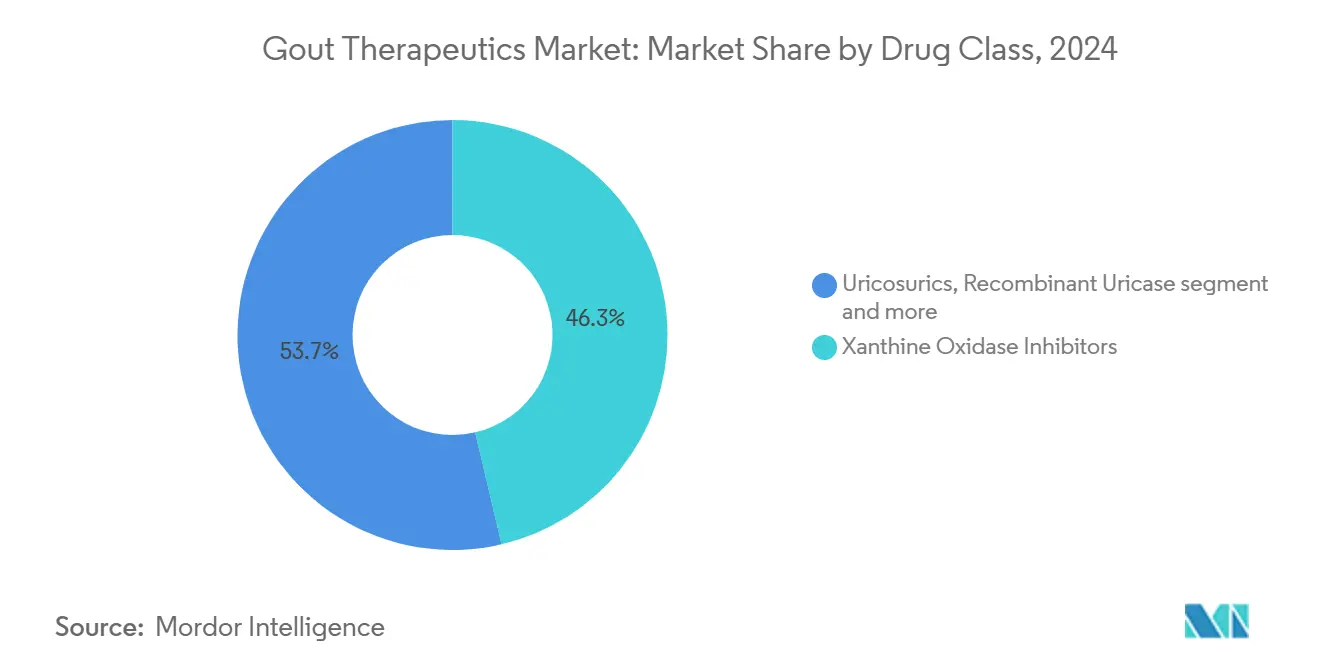
Note: Segment shares of all individual segments available upon report purchase
By Route of Administration: Injectable Growth Outpaces Oral Dominance
Oral products generated 81.23% of 2024 revenue and remain indispensable for chronic therapy initiation, yet injectables are accelerating fastest at 8.45% CAGR as biologics penetrate earlier lines of care. Infusion-center build-outs and specialty-pharmacy expansion cut wait times and streamline reimbursement, lowering historical barriers associated with intravenous pegloticase. In real-world registries, pegloticase plus methotrexate achieves sustained serum-urate targets in two-thirds of previously uncontrolled patients, validating the clinical proposition for high-acuity cohorts. Injectable ACTH (Cortrophin Gel) is also gaining share in acute flare management, and its Phase 4 study seeks optimal dosing to capture under-served hospital and ambulatory settings.
Despite convenience advantages, oral adherence remains sub-optimal, driving interest in depot formulations and transdermal patches that could blur the oral-injectable divide. Developers are testing subcutaneous uricase candidates and long-acting IL-1 inhibitors aimed at quarterly dosing, potentially altering the calculus of patient preference. Should these formats prove non-inferior, injectable revenue could surpass earlier forecasts, further reshaping the gout therapeutics market.
By Disease Type: Tophaceous Gout Drives Therapeutic Innovation
Chronic refractory gout represented 52.40% of the gout therapeutics market size in 2024, but tophaceous gout’s projected 8.89% CAGR signals the next frontier of revenue growth. Advanced imaging—including ultrasound and dual-energy CT—detects monosodium-urate deposits sooner, expanding treatment-eligible cohorts mdpi.com. AR882’s 50% complete tophus resolution underscores the power of targeted URAT1 inhibition, while pegloticase combinations are setting new efficacy benchmarks in patients with established nodules. Such visible clinical gains translate into higher patient acceptance of biologic infusions despite cost and logistical hurdles.
Health-economic studies demonstrate that averting joint destruction and disability justifies biologic outlays, and payers increasingly reimburse aggressive early intervention. The therapeutic race for tophus clearance also catalyzes development of imaging-based companion endpoints, unlocking streamlined regulatory paths. Consequently, tophaceous gout’s expansion materially widens the gout therapeutics market and incentivizes pipeline investment in interventions capable of rapid tissue urate dissolution.
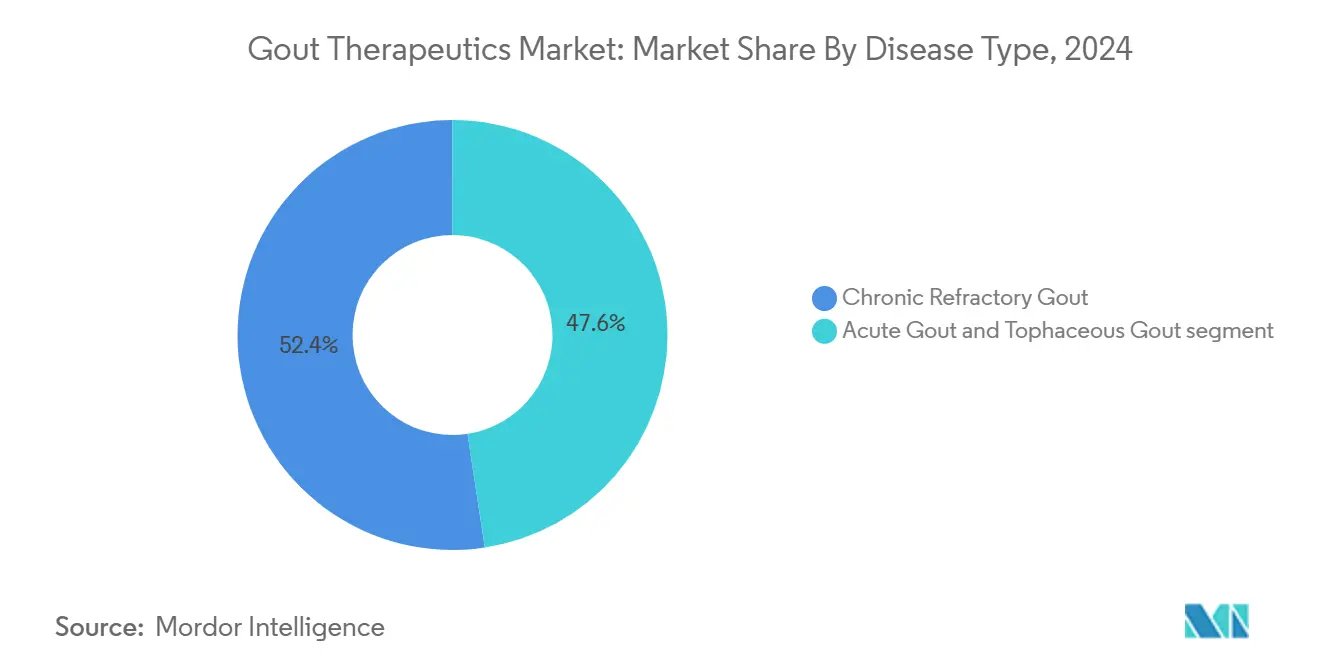
Note: Segment shares of all individual segments available upon report purchase
Geography Analysis
North America generated 41.72% of 2024 revenue owing to early biologic adoption, broad insurance coverage, and widespread specialist availability. Treat-to-target guidelines enjoy strong professional-society endorsement, and payers often reimburse serial serum-urate tests, sustaining higher per-patient spending. The region’s dominance is reinforced by active clinical-trial networks that accelerate access to investigational URAT1 inhibitors and IL-1 biologics. Nevertheless, boxed-warning fallout and febuxostat discontinuation are reshaping formularies and nudging prescribers toward emerging mechanisms.
Europe contributes steady growth as universal coverage and stringent price controls temper margins. Uptake of biosimilars is higher, and health-technology assessment bodies require robust real-world data, slowing diffusion of new entrants. Yet the continent’s aging demographics and rising obesity sustain underlying demand, and centers of excellence in rheumatology produce influential guideline updates that ripple globally.
Asia-Pacific posts the highest 9.34% CAGR as rapid urbanization escalates metabolic syndrome prevalence. China’s gout prevalence is climbing alongside insurance expansion, prompting local firms such as LG Chem and JW Pharmaceutical to launch URAT1 programs that combine competitive pricing with tailored genetic screening. Pacific Island nations display some of the world’s highest serum-urate levels due to genetic predisposition, spurring public-health campaigns that could translate into pharmaceutical uptake once budget allocations rise. Tele-rheumatology and e-pharmacy platforms facilitate outreach to rural populations, amplifying product reach and strengthening the gout therapeutics market across diverse income strata.
South America and the Middle East/Africa together account for a smaller share today but exhibit double-digit unit growth as generics become more accessible and governments invest in non-communicable disease management. Sub-Saharan initiatives to train primary-care physicians in gout diagnosis, plus donor-funded screening programs, foreshadow future volume gains. Multinationals that localize manufacturing or deploy tiered-pricing models can capture early-mover advantages as these healthcare ecosystems mature.
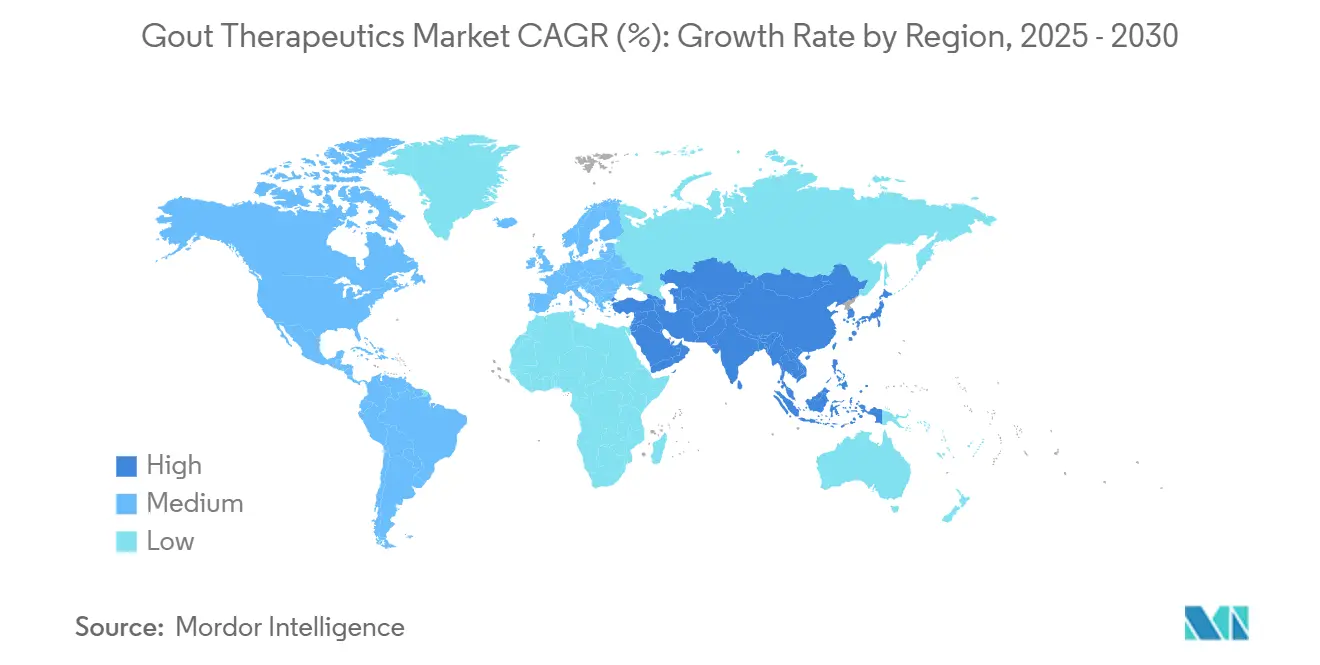
Competitive Landscape
Post-acquisition, Amgen wields a commanding presence through Krystexxa, the only FDA-approved recombinant uricase, and leverages combined commercial infrastructures to deepen specialist penetration. The FTC consent order prohibits bundling Krystexxa with Amgen’s immunology franchise, yet economies of scale in patient-support programs remain. Arthrosi Therapeutics’ USD 75 million Series D signals investor appetite for assets capable of challenging entrenched biologics; AR882’s oral route and tophus-resolution data position it as a potential first-line option in refractory settings.
Selecta-Sobi’s SEL-212 illustrates a strategic pivot toward immunomodulation plus urate degradation, potentially lowering anti-pegloticase antibody formation and extending response durability[2]Source: Sobi AB, “Sobi initiates rolling biologics license application to FDA for SEL-212,” sobi.com . XORTX Therapeutics is advancing XRx-026 for allopurinol-intolerant patients, targeting an orphan segment and exploiting expedited regulatory incentives. Meanwhile, ANI Pharmaceuticals is repositioning Cortrophin Gel for inpatient flares, broadening its label use through post-marketing research.
Digital-health entrants are carving ancillary revenue streams by licensing wearable uric-acid sensors to pharma partners for pharmacovigilance and adherence monitoring. AI-assisted drug-discovery firms are screening libraries against URAT1 and GLUT9 targets, promising shorter pre-clinical cycles. Collectively, these moves intensify innovation and diversify mechanisms, enhancing resiliency and expanding the overall gout therapeutics market.
Global Gout Therapeutics Industry Leaders
-
Lannett Company, Inc
-
Horizon Therapeutics plc
-
Takeda Pharmaceutical Company Ltd
-
GlaxoSmithKline Plc
-
Regeneron Pharmaceuticals, Inc.
- *Disclaimer: Major Players sorted in no particular order
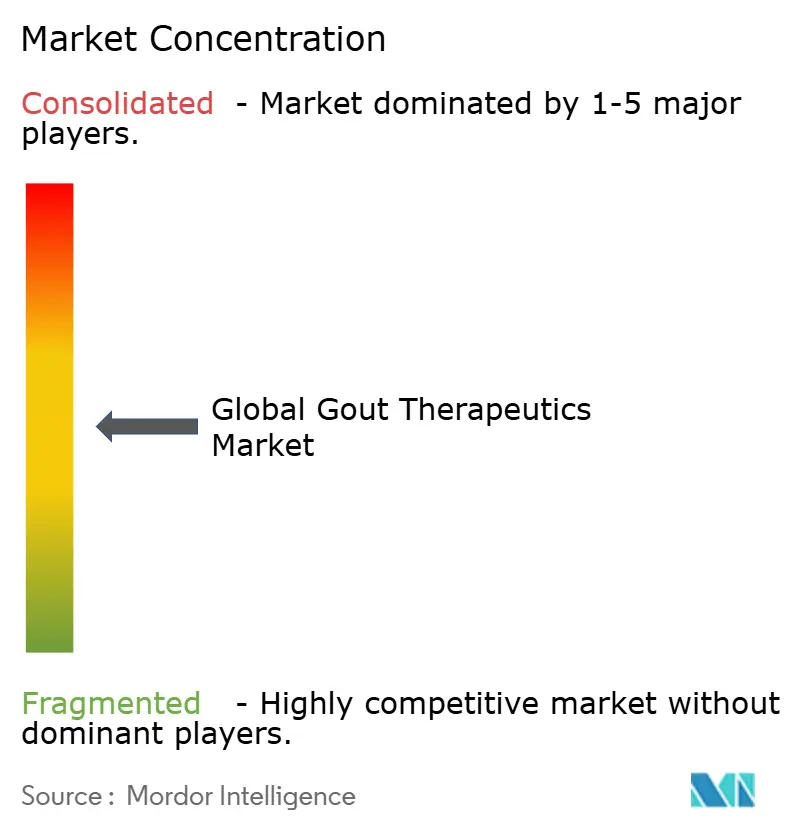


Recent Industry Developments
- January 2025: Takeda discontinued branded Uloric (febuxostat) manufacturing and distribution, citing market share erosion to 3% amid generic competition, with final wholesaler shipments through Mar 2026.
- January 2025: XORTX Therapeutics launched late-stage XRx-026 program for allopurinol-intolerant gout, pursuing orphan designation and FDA discussions within 2025 XORTX Therapeutics.
- August 2024: Arthrosi Therapeutics received FDA Fast Track for AR882 in tophaceous gout, accelerating review timelines.
Research Methodology Framework and Report Scope
Market Definitions and Key Coverage
Our study defines the gout therapeutics market as prescription drugs that lower serum urate or control acute gout inflammation, including xanthine-oxidase inhibitors, uricosurics, biologic uricases, colchicine, NSAIDs, corticosteroids, interleukin-1 blockers, and pipeline URAT1 inhibitors delivered through oral or injectable routes across all care settings. We treat every product as new, branded, or generic revenue recognized by manufacturers before distributor margins, and we convert all currencies to constant 2024 USD for clean comparison.
Scope exclusion: vaccines, over-the-counter dietary supplements, and surgical interventions are outside this assessment.
Segmentation Overview
- By Drug Class (Value)
- Xanthine Oxidase Inhibitors
- Uricosurics
- Recombinant Uricase
- Colchicine
- NSAIDs
- Corticosteroids
- IL-1 Inhibitors
- Others
- By Route of Administration (Value)
- Oral
- Injectable
- By Disease Type (Value)
- Acute Gout
- Chronic Refractory Gout
- Tophaceous Gout
- By Geography (Value)
- North America
- United States
- Canada
- Mexico
- Europe
- Germany
- United Kingdom
- France
- Italy
- Spain
- Rest of Europe
- Asia-Pacific
- China
- Japan
- India
- South Korea
- Australia
- Rest of Asia-Pacific
- Middle East and Africa
- GCC
- South Africa
- Rest of Middle East and Africa
- South America
- Brazil
- Argentina
- North America
Detailed Research Methodology and Data Validation
Primary Research
Our analysts held structured interviews with rheumatologists, hospital pharmacists, and payor-policy managers across North America, Europe, and Asia-Pacific. These conversations sharpened assumptions on drug persistence, boxed-warning impact, and average selling prices, thereby plugging gaps left by secondary data and guiding final triangulation.
Desk Research
We began with disease prevalence and treatment-rate baselines from open data sets such as the Global Burden of Disease, CDC NHANES, WHO Global Health Observatory, and Eurostat. Regulatory approvals and clinical-trial registries helped us log launch timelines and label expansions, while customs shipment dashboards and IMS health audit snapshots illustrated regional demand pockets. Annual reports, investor decks, and Form 10-Ks of leading developers were mined through D&B Hoovers and Dow Jones Factiva to retrieve therapy revenue splits, price corridors, and pipeline milestones. Additional context came from specialty-society guidelines, peer-reviewed journals, and patent analytics from Questel. This list is illustrative only; many other credible feeds were consulted for cross-checks and clarification.
Market-Sizing & Forecasting
A top-down prevalence-to-treated-cohort build was created, and then selective bottom-up supplier roll-ups of sampled ASP × volume validated totals and highlighted leakage. Key variables include diagnosed gout prevalence, urate-lowering therapy penetration, biologic share shift after safety advisories, regional reimbursement ceilings, and mean annual treatment intensity. Multivariate regression combined with scenario analysis projected each driver under baseline, optimistic, and restrained outlooks, and results were converted to a single midpoint forecast.
Data Validation & Update Cycle
Outputs pass through anomaly checks, peer review, and senior sign-off. We refresh every model once a year, with interim pulses triggered by material label changes, guideline updates, or disruptive launches, ensuring clients always receive a recently audited view.
Why Our Gout Therapeutics Baseline Commands Reliability
Published market values frequently diverge because firms apply different product mixes, price metrics, and refresh cadences. We acknowledge these contrasts upfront so decision-makers can benchmark confidently.
Key gap drivers include inclusion of over-the-counter uric-acid supplements by some publishers, currency conversions at spot rather than average annual rates, unvalidated uptake curves for late-stage biologics, and shorter update cycles that miss February 2025 boxed-warning revisions.
Benchmark comparison
| Market Size | Anonymized source | Primary gap driver |
|---|---|---|
| USD 3.03 B (2024) | Mordor Intelligence | - |
| USD 2.82 B (2024) | Global Consultancy A | Excludes recombinant uricase class and uses retail-sales values before manufacturer rebates |
| USD 2.40 B (2024) | Regional Consultancy B | Applies conservative therapy rate of 17 % vs our validated 23 % and omits Japan |
| USD 3.22 B (2025) | Trade Journal C | Uses list prices without country-specific discount factors and projects uniform CAGR |
The comparison shows that, by selecting a clear product scope, applying real-world discount rates, and revisiting inputs after every regulatory shift, Mordor Intelligence delivers a balanced baseline that remains transparent, traceable, and repeatable for strategic planning.


Key Questions Answered in the Report
What is the current size of the gout therapeutics market?
It was valued at USD 3.03 billion in 2024 and is projected to reach USD 4.65 billion by 2030.
Which drug class holds the largest gout therapeutics market share today?
Xanthine oxidase inhibitors lead with 46.34% of 2024 revenue.
Why are URAT1 inhibitors gaining attention?
They post the fastest 8.12% CAGR and stay effective in patients who carry ABCG2 gene variants that blunt allopurinol response.
Which region will grow the fastest through 2030?
Asia-Pacific shows a 9.34% CAGR, driven by aging demographics and improved healthcare access.
How are safety concerns affecting market dynamics?
The boxed warning on febuxostat strains its uptake, pushing prescribers toward alternative mechanisms such as URAT1 inhibitors and biologics.
Page last updated on:
